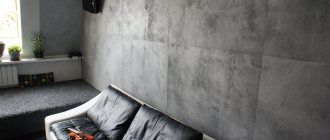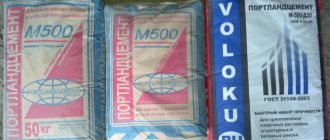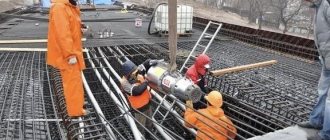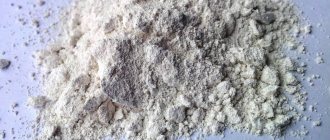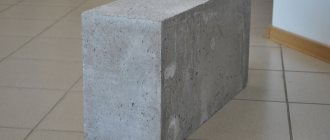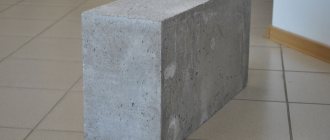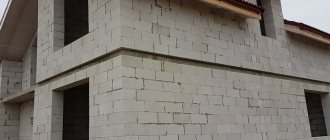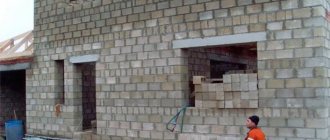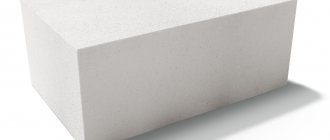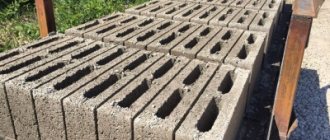The production of foam concrete blocks is usually called a new technology in construction. Compared to the age of concrete, this is, of course, true, but it does not quite correspond to modern society’s ideas about the new.
Thus, foam concrete has been used in the construction industry for just over 100 years. The material is inferior to classical concrete in terms of strength (in the first tens of years of operation, but more on that below), but the cost is much more attractive.
The large size of foam concrete blocks and excellent thermal insulation qualities have made them very popular in the construction of private houses and functional buildings (garages). Supply responded to the growing demand. And simple technology has opened up a lot of opportunities for manufacturers who are not always ready to follow the rule “price is justified by quality.” As a result, a lot of materials appeared on the market that did not meet the declared characteristics in terms of size, strength, or weight.
To distinguish a good product from a dubious one, you need to understand what foam blocks are and what their advantages and disadvantages are. This will be discussed below.
About foam concrete blocks
Foam concrete blocks are a popular building material; they belong to the class of cellular concrete due to the specifics of production. For their manufacture, a standard cement-sand mixture with water is used (as for concrete), but with the addition of foaming agents. This allows you to reduce the amount of cement by 2–4 times.
The following can act as foaming agents:
- synthetic compounds (not recommended for the production of blocks for the construction of residential buildings, due to the toxicity of synthetic foaming agents, and the strength of products with them is lower);
- protein – organic – additives (environmentally friendly, provide good strength and are inexpensive).
To increase the strength of the material, construction micro-reinforcing fiber or fly ash (dry/fly ash) can be added to its composition. All components are mixed under pressure, foaming occurs at the very end of the process, after which the mixture is poured into molds (large and small). Large foam concrete pieces are subsequently cut, achieving a more precise geometry compared to piece molding in separate containers.
The main characteristics (including what sizes foam blocks are) are determined by GOST 25485–89, GOST 21520–89 and GOST 5742–76. Based on these standards, it is easy to calculate how many products will be needed to build a future bathhouse, for example, or a garage.
It is important. Cement binders are used in the formulations of foam concrete blocks, because their (blocks) strength is not formed immediately and continues to increase over the years (already in the structure of the building). As the examination shows, the strength of foam concrete after 30–40 years can exceed its original value by 4 times.
Technical characteristics of foam blocks
When choosing, it is recommended to pay attention to the following technical characteristics of the foam block:
- Frost resistance. Determined by the number of cycles (freezing/thawing, 1 cycle - 1 change of seasons with a decrease in the average daily temperature to a marginal negative value) that the material can withstand. The frost resistance of foam concrete differs depending on the quality of the components used and the type of foaming agent. Minimum – F15, maximum – F75 b F100. Blocks with frost resistance of 75 cycles can be used in the Arctic Circle.
- Density. It determines the grade of material, is measured in kg per cubic meter and varies between 300–1200 kg/m3.
- Thermal conductivity. Depends on the brand of products and ranges from 0.09–0.38 W/m* °C.
- Weight. At normal humidity, 1 block weighs from 8.5 to 47 kg, depending on density.
- Foam block size. It is up to 600 mm in length, from 200 to 400 in width, and 90–300 mm in thickness. It is worth noting here that the production technology makes it possible to produce products of any size, but in private low- or multi-story construction it is recommended to rely on the size table GOST 21520–89. We’ll look at the typical dimensional indicators in more detail below.
It is important. The main characteristic of foam concrete, which determines its purpose, is density, calculated as the ratio of mass to volume of the block. In the marking it is designated by the letter D.
Types of foam blocks
Depending on the density, which depends on the number of pores (the fewer there are, the stronger and heavier the material, the higher its cost), foam concrete is divided into 3 main classes.
- The most budget-friendly type is thermal insulation. These are blocks D300, 350, 400 and 500. They are lightweight, inexpensive, excellent thermal insulation of rooms, but do not have sufficient strength to be used in load-bearing structures. Such materials are used for the construction of internal partitions, sound and heat insulation and cladding of building facades.
- Structural and thermal insulation types of foam blocks have a density of D600, 700, 800, 900. These products can already be used for the construction of internal load-bearing and external walls.
- Structural - the most durable, dense and strong blocks of the D1000, D1100 and D1200 brands. They are used for the construction of the box of a private house or any other important building.
Foam block sizes
The following foam block sizes for construction are considered standard.
- For partitions that are not load-bearing, as well as in the external structure of facade cladding - 600 * 300 * 100 mm (length, height and thickness, respectively). Moreover, depending on the location of the block, the parameters of width and thickness (which determines the thickness of the wall) may vary.
- For load-bearing walls indoors – 600*300*200 mm.
- For load-bearing walls of the building box – 600*400*200 mm.
The most common format for private construction (house, garage, bathhouse) is 600*300*200 mm - identical in size to 18.5 units of single brick. This comparison clearly demonstrates one of the undoubted advantages of foam concrete - saving money on building materials. If you take a block 400 mm thick for an external wall, you can get masonry with a level of insulation that a brick can only provide with a thickness of 1.7 m.
In addition to standard ones, large sizes of foam blocks for walls are also used. They are called block panels, and their dimensions are as follows:
- length – 1000 mm;
- height – 600 mm;
- thickness – from 300 to 600 mm.
The most common standard size in the large format series is 1000*600*500 mm. There are also models 1000*600*400, 1000*600*500 and 1000*600*600 mm.
It is important. When choosing a foam concrete block, you need to look not only at its size, but also at the shape - geometry - of the product. Materials made in home-garage conditions are distinguished by uneven width and thickness along the entire length.
Weight of foam blocks
The weight of the foam block, in contrast to its size, directly depends on the brand (that is, density, number of cells in the concrete structure). The lower the density, the lighter the product. Range - from 8.5 to 43.2 kg. Calculating the weight of a specific product, knowing its brand and size, is quite simple.
- You need to determine the volume of the block (multiply the length, height and thickness, first converting them to meters). For a standard product 600*300*200 mm, for example, it will be 0.6*0.3*0.2 = 0.036 m3.
- Density must be multiplied by volume. For example, for brand D1000 it will be 0.036*1000 = 36 kg. A block of the same size, but from the class of structural and thermal insulation materials, D600, will weigh 0.036 * 600 = 21.6 kg.
Since foam concrete blocks are usually sold in cubic meters (1000 m3 per pack), their weight is also determined on the basis of 1 cubic meter. m. In this case, it will be equal to or slightly greater than the declared density (grade). For the examples given under normal humidity conditions (55–65%), these are 1000 and 600 kg.
Deviations in a larger direction are explained by acceptable inaccuracies in dimensions, which are inevitable when casting blocks in piece molds. In addition, the weight of the products greatly depends on the humidity level (if it is 75% or higher, the parameter will vary between 11.7–47.5 kg). On manufacturers' websites you can usually see a table with the exact weight parameters of a cubic meter of material for each brand.
Choosing foam concrete correctly - selection criteria
1.
First of all, look at who exactly makes these foam blocks. Ask for a certificate, check the delivery conditions and compliance of the products with GOSTs. If a manufacturer openly provides maximum information, it means that he has nothing to hide, and his material is of appropriate quality.
By the way, this is what large companies, reliable and well-proven, do. A good foam block manufacturer usually has a production area of at least 180 square meters, on which there is a block cutting machine. Moreover, the production premises must be heated and have a roof.
2.
Price matters too. On average, for the D800 brand it is about $80 per cubic meter. If the material is much cheaper, you should think about it - this may affect the quality.
And one more thing: if the manufacturer convincingly declares that its D600 foam concrete is structural, as it is made using a “secret” technology, do not believe it. No special recipes, no subtleties of technology can turn one brand into another. You can’t even lay out a small one-story house with such blocks - this brand of material cannot be used for load-bearing walls.
3.
Carefully inspect the blocks - they should not be pure and bright white. Technology will not allow this. Normally, foam concrete should be greyish, slightly lighter or darker, and uneven coloring of the surface is not allowed.
4. Check how tight the foam concrete cells are.
If they are connected to each other, moisture will easily penetrate into the material. Split one block and see if its structure is the same on the outside and inside. The cells must be round; no chips or cracks are allowed.
5. To lay walls without problems, the blocks must be strictly rectangular - check this.
Having placed two foam blocks one on top of the other, try to shake them, see if there are any gaps. Moreover, examine all four sides of the blocks - this is important, since there may be a flaw on only one side. And in the future, this can take up a lot of your time and ruin your nerves.
6. Having purchased fresh material, you should not immediately use it to build walls. After all, foam concrete blocks will acquire the necessary strength and other technical characteristics only 28 days after production.
Therefore, the most correct solution would be to let the purchased foam concrete stand for two or three weeks. In this case, it must either be well protected from moisture or be indoors. This will help you avoid trouble if you were sold underexposed material.
An example of improperly organized storage of foam blocks; they are not covered with anything on top and it is already clear that they have absorbed moisture from the damp earth.
Pros and cons of foam blocks
Already from what is said above, it is easy to deduce the main pros and cons of foam concrete blocks. Thus, their advantages for private construction of houses and other functional structures include:
- environmental friendliness (products with organic foaming agents);
- low thermal conductivity;
- excellent sound insulation properties;
- frost resistance;
- durability when exposed to negative factors (does not rot, does not mold);
- light weight (minimal load on the foundation);
- universal character (from facades to walls of a private house);
- convenient sizes of foam concrete block for walls;
- fire safety (I degree of fire resistance).
Flaws
The disadvantages of the material include its simple appearance (additional finishing is needed), imperfect geometry of individual blocks, due to which the consumption of laying adhesive increases (minimum thickness 2 mm) and a large number of materials made in artisanal conditions. In addition, foam concrete walls in a multi-story structure require reinforcement.
It is quite difficult to secure a relatively heavy structure (for example, a facing panel) to the surface of cellular concrete. Although the fasteners fit into it as easily as into wood, they hold less well due to their fragility. To fix the elements, special anchors and other devices are used specifically for foam concrete foundations.
It is important. Simple manufacturing technology allows you to make foam blocks directly on the construction site. But it is unacceptable to immediately put them into construction. For foam concrete to achieve brand strength, it must dry for at least 27 days and be used on the 28th day (the shelf life must also be checked when purchasing material from production sites).
Introduction
In the construction industry and private housing construction, various building materials are used to construct the walls of houses. Foam block is one of the most common building materials used in low-rise construction. Due to its relatively low cost, foam block is increasingly attracting the attention of potential home owners. But at the same time, people do not know what a foam block is. Which foam block to choose for building a house. In this article we will describe all the advantages and disadvantages of foam blocks.
Foam block is a building block made from foam concrete. Foam concrete is a type of cellular concrete. It is made from a solution consisting of cement, sand, water and a special foaming agent. Foam concrete is produced using cement binding material. Therefore, after production, foam concrete continues to gain strength for a long time. This should be taken seriously when purchasing a batch of foam blocks. Foam concrete and, accordingly, foam block have a porous structure due to numerous closed pores (air bubbles).
Advantages of foam blocks
Foam block has become widespread in the construction industry and in private housing construction due to its following advantages:
- the density of the foam block is sufficient for the construction of durable low-rise buildings;
- the thermal conductivity of the foam block is the lowest among other porous building materials;
- the frost resistance of the foam block allows it to be used in the construction of low-rise construction projects in northern latitudes;
- the moisture absorption of foam blocks is the lowest among the most common porous building materials;
- the durability of the foam block is quite sufficient to consider a house built from foam blocks as a permanent structure;
- ease of handling foam blocks during construction is due to their relatively low weight;
- the relatively high speed of construction of houses made of foam blocks due to its large dimensions;
- environmental friendliness of foam blocks produced using organic foaming materials;
- fire resistance of foam block;
- resistance of the foam block to biological effects;
- high soundproofing properties of the foam block due to its porous structure;
- lower cost of foam block compared to other building materials.
Disadvantages of foam block
In addition to the undoubted advantages described above, foam blocks have a number of disadvantages, namely:
- the fragility of foam blocks, which requires special attention when transporting the blocks and, directly, when erecting the walls of houses;
- shrinkage of foam blocks, requiring long-term storage of blocks in a warehouse after production.
There is also a main drawback of foam blocks, but we will talk about it at the end of this article.
Let's return to the topic of our article “Which foam block to choose for building a house.”
To decide which foam block to choose for building a house, you need to know well the features of the foam block. And also clearly understand the place of each foam block and its purpose in the structure of the house.
Scope of use of foam blocks
Foam concrete blocks are universal and can be used:
- for insulating premises – residential and non-residential;
- insulation of technical structures (including wells);
- installation of interfloor ceilings (in order to reduce the load on the foundation of a multi-story building);
- partitions in large high-rise buildings;
- construction of load-bearing walls (foam blocks of standard sizes, grades D1000–D1200) and much more.
One- and two-story private houses for permanent residence, garages for 1–2 cars, bathhouses, workshops, country workshops, warehouses, hangars are built from foam concrete blocks.
Summary
Before drawing a conclusion regarding the main characteristics of foam blocks, it is worth noting that this building material is often identified with aerated concrete. Which is logical: their production technologies are similar, their properties are similar, even the state standards that regulate the requirements for their quality are the same. Only the structure and process of their production differ.
When creating foam block materials, a foaming agent is added to the already prepared mixture to increase its size (foam is formed, the material is filled with closed cells). Aerated concrete is produced through a chemical reaction - a foaming component (aluminum shavings) is added immediately, and when mixed (sand, cement and water), it gasifies it. As a result, cells are also formed, but they are not as uniform as those of foam concrete.
Returning to the types of foam block, it is worth noting that its size and weight are not only important characteristics when choosing products (for a specific project). Being standardized values, they allow you to accurately determine the need for building materials:
- count the number of products in a row of masonry (the length of all sides of the house box divided by the length of the block);
- determine the number of rows in the wall (divide the height of the wall by the height of the block);
- multiply the number of products in a row and the number of rows, add 10–15% of the stock - and you can order a complete set.
The only important clarification: the weight of products may vary depending on the level of humidity and production technology, and the dimensions are not accurate for everyone. Therefore, before purchasing, it is always useful to make sure that you are dealing with a proven, reliable supplier who offers only high-quality building materials and guarantees that their characteristics comply with the declared parameters.
Purpose
The blocks are made from a mixture of lime-sand cement, ground sand, blowing agent and water by forming, followed by hardening under the action of steam in an autoclave.
Designed for laying external, internal walls and basement walls and partitions of buildings, with a relative humidity of no more than 75% and in a non-aggressive environment (in rooms with air humidity of no more than 60%, the inner surface of the external walls of the blocks must have a vapor barrier coating), for the installation of thermal insulation of external walls of buildings and structures.

